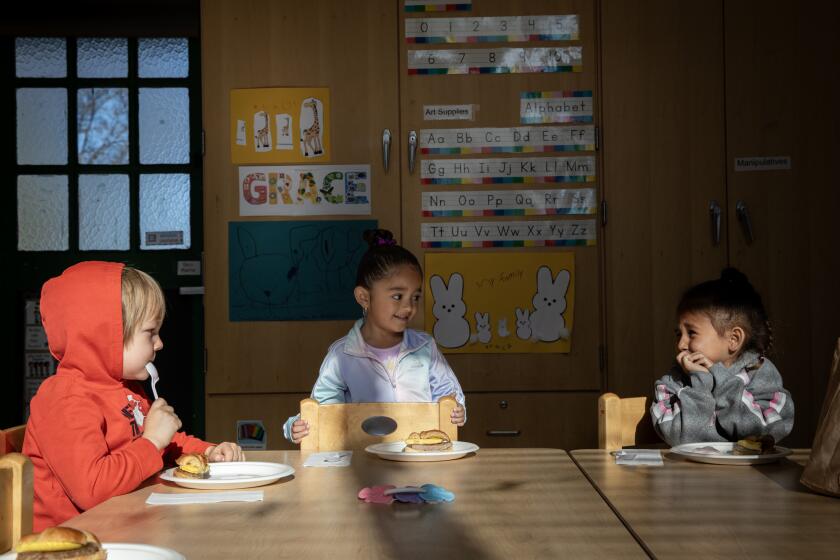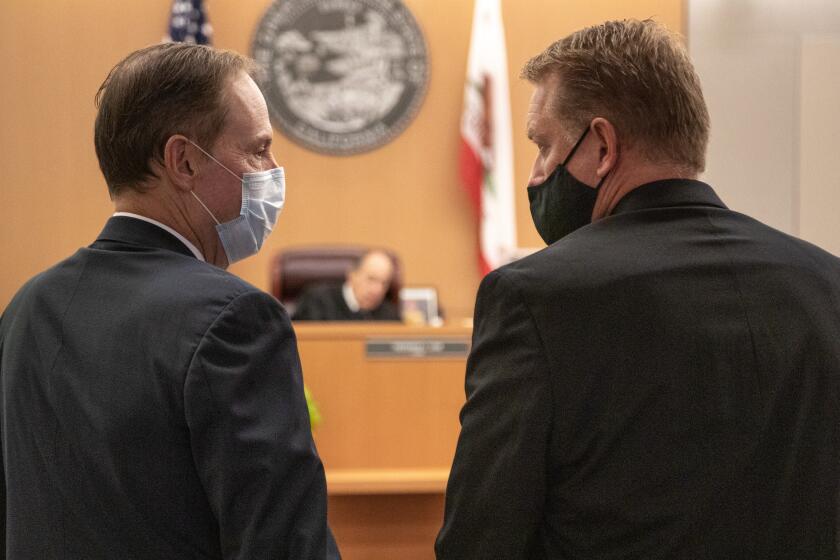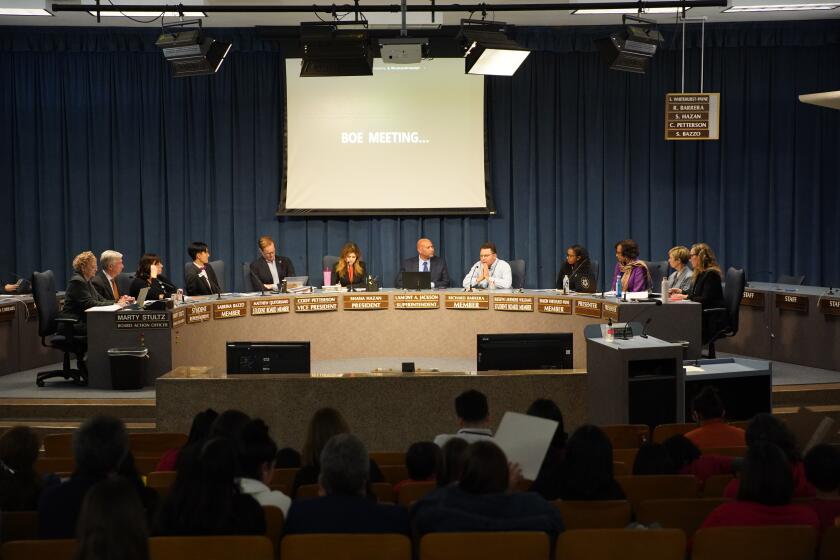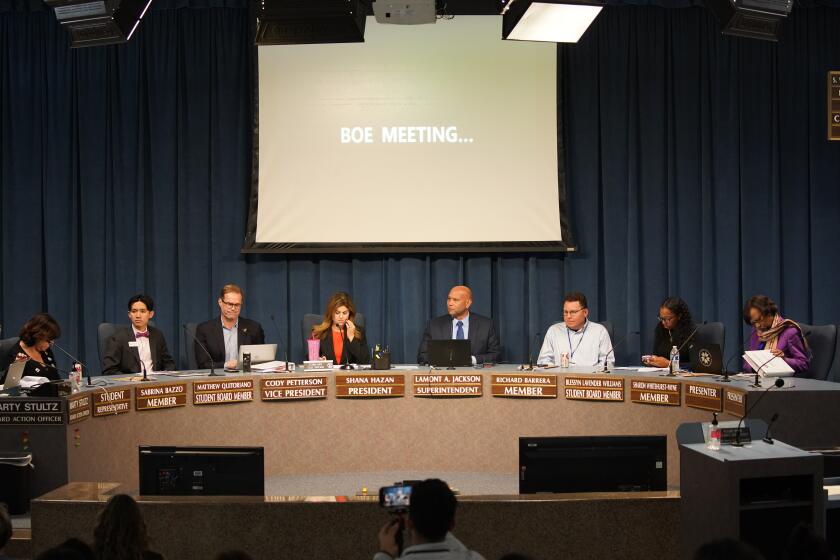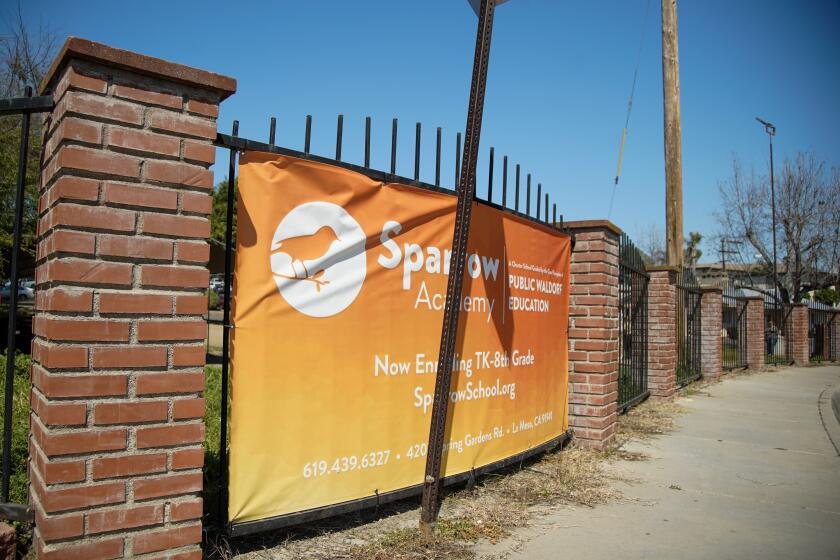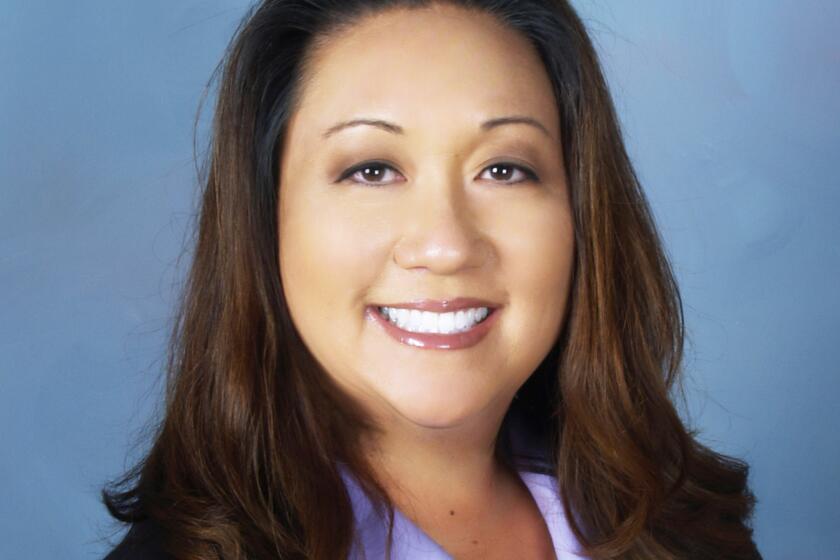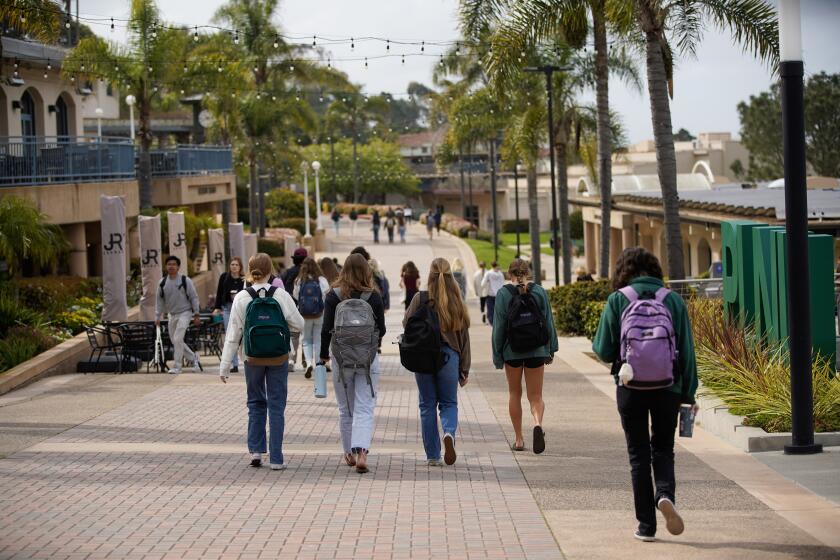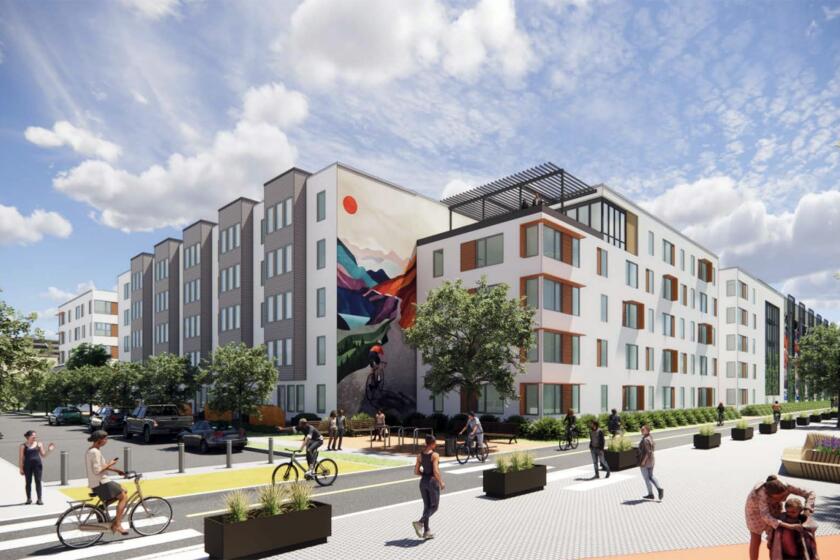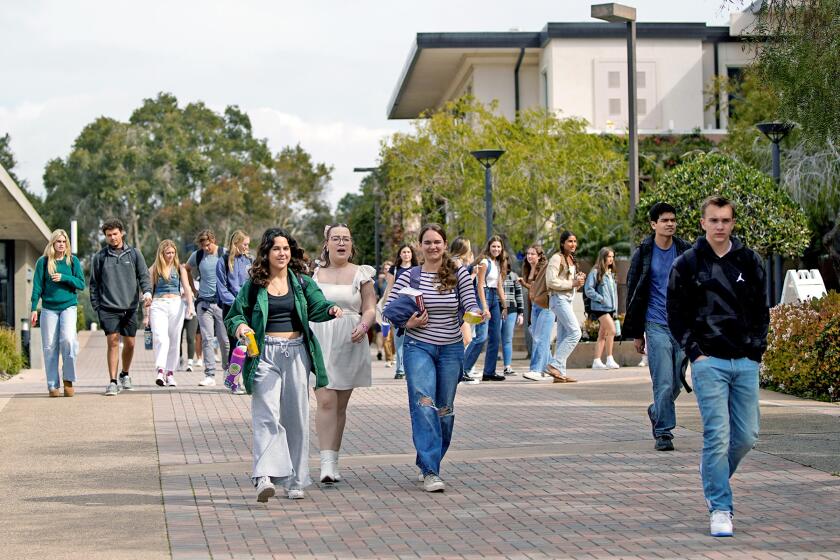Students call for defunding of San Diego school police

Protesters say school police presence harms Black students; officials say police are there for safety
More than 200 people protested at San Diego Unified’s headquarters Thursday afternoon, calling for the complete defunding of the district’s school police. Students said a police presence in their schools leads to increased punishment and arrests that disproportionately hurt Black and Hispanic students.
Their protest is part of a national surge linked to the Black Lives Matter movement and spurred by the police killing of George Floyd, a Black man in Minneapolis. Some protesters nationwide are scrutinizing police operating in public schools.
Organizers of Defund School Police SD, the student-run group behind Thursday’s protest, said they want money currently paying for school police to instead be used to hire more school counselors and Black and Indigenous teachers and fund more student services such as restorative justice and mental health programs.
“We believe all students should be able to be in a learning environment without worrying if cops will be around to bother them,” said Shukriya Osman, a 15-year-old sophomore at Bright Horizon Academy and a Black student organizer. “With the cops on campus, Black and people of color students feel unsafe.”
San Diego Unified founded its school police department in 1984. It has 37 sworn officers and spent $9.6 million in the 2019-20 school year, according to the district, out of an overall budget of $1.4 billion.
Some school districts like San Diego are large enough to have their own police force, while other districts, including at least 10 in San Diego County, contract with local law enforcement agencies that provide school resource officers, who are police officers trained specifically to work with minors in schools.
School resource officers and school police are meant to keep students and schools safe. But having law enforcement personnel in schools makes many students of color feel unsafe, student activists say.
“It’s exhausting to be on campus and not only worry about being a student but being a criminal in their eyes,” said Senait Hagos, a Black Defund School Police SD organizer and an 18-year-old graduate of Gompers Preparatory Academy, a charter school run independently of San Diego Unified.
Organizers said students should be able to focus solely on getting an education without having to worry about whether they could be arrested at school for, say, speaking out of turn or getting caught up in an altercation.
Jazlyn Bass, a 16-year-old organizer and a Mira Mesa High School senior, said she has seen fellow Black female classmates yelled at by school security guards and threatened with expulsion. She and other organizers described how, due to racial biases, some police officers view Black students as violent or dangerous.
“As a Black student, you kind of get used to the trauma that’s inherent to having to defend your innocence on a regular basis,” said Endiya Griffin, a Black 17-year-old graduate of San Diego Met High and a student organizer. “If you speak too loudly, you seem violent.”
Police officers who work in schools say they are needed to protect students and staff from threats such as school shootings, human trafficking and Internet crimes against children.
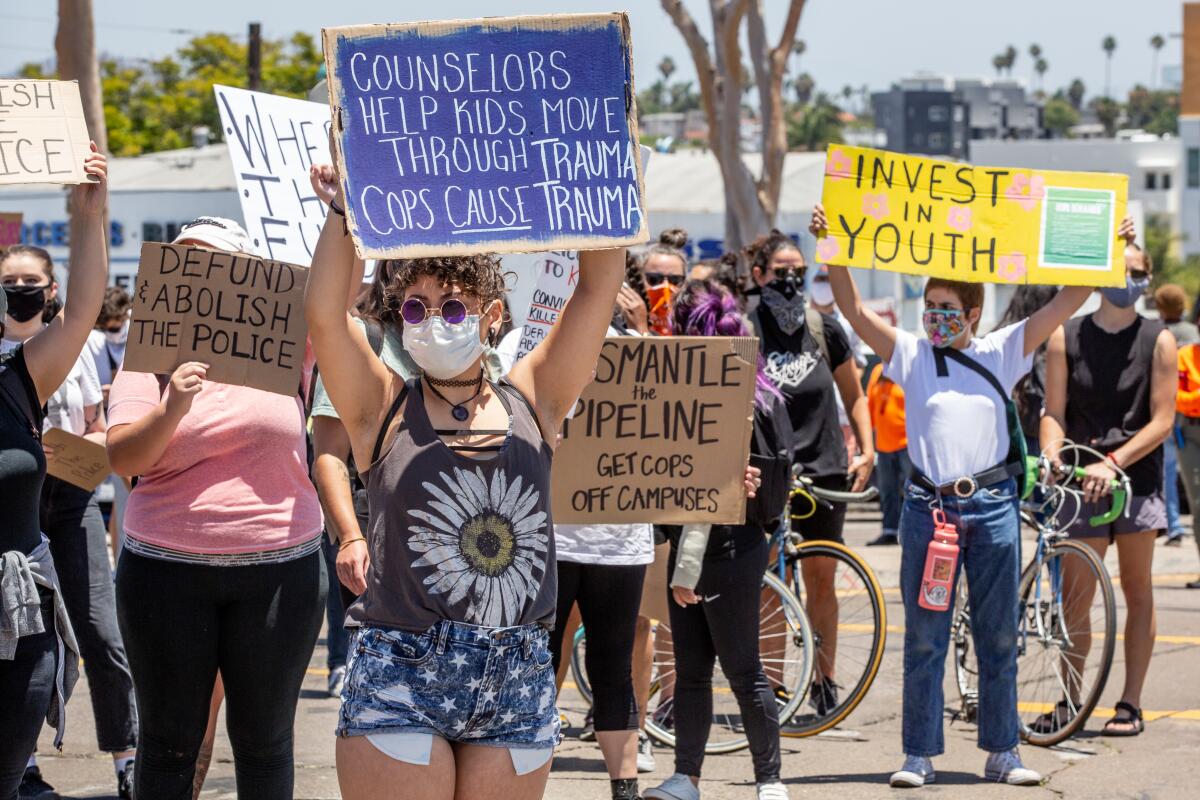
School police work with administrators to write school safety plans and train staff on what to do in the event of an active shooter on campus. They handle such incidents as students bringing weapons or drugs to school. School police or resource officers are sometimes called to help when students are going through psychological emergencies, such as attempted suicide.
San Diego Unified School police Chief Michael Marquez said his department’s job is not to criminalize students but to keep them safe, build relationships with them and help them form positive perceptions of police.
Marquez said his officers are already implementing restorative justice, which involves addressing the reasons why someone committed an offense, rather than punishing them for it. San Diego school police get training about implicit bias, trauma-informed response, de-escalation tactics, adolescent brain development, psychology emergency response and more, he said.
“We want our children in our community to trust the police,” said Marquez, who has been with the school police department for 19 years.
“We welcome the conversation because I’m a Hispanic chief, I’m a native San Diegan, I grew up in Logan Heights and National City,” Marquez said. “If we have children of color that are fearful of police, then we are doing something wrong and we need to change that.”Growing scrutiny
San Diego is one of a growing number of school districts nationwide whose use of police is coming under scrutiny.
Oakland Unified’s school board recently voted to dismantle its entire school police department, and Los Angeles Unified’s voted to cut its school police budget by 35 percent after protesters had called for the removal of the departments.
San Diego Unified School Board President John Lee Evans said the board should listen to what students think at a July 21 workshop that will discuss several racial equity issues, including school police, curriculum, school discipline and hiring for diversity.
“There are a lot of other things which could mitigate the need for us to have police on the campus,” Evans said.
Board Trustee Sharon Whitehurst-Payne said, as an African American she understands students’ concerns, but what also needs to be considered is that students protested two years ago because they felt unsafe at school amid several school shootings nationwide.
“I think we need to have a balance,” Whitehurst-Payne said. “We need to weigh what needs to be done, and we will do that in a thoughtful, logical manner.”
While officials say school police protect against external threats, several analyses have found that having police in schools leads to more arrests and discipline of students at schools, with Black students being disproportionately affected.
A KPBS analysis of 12 years of San Diego Unified school police arrest data showed that Black students were four times more likely to be detained than White students.
One 2016 study found that having designated police in schools leads to more arrests, particularly among children under 15, and more arrests for drug crimes, even as it improves school safety.
Another study in 2018 found that federal grants for school police led to an increase in discipline rates of middle school students, especially Black and Hispanic students, as well as decreases in graduation and college enrollment rates.
A UCLA analysis of three years of Los Angeles Unified school police data found a quarter of police enforcement actions involved Black students, even though Black students represented less than 9 percent of the student body. A quarter of the arrests were against elementary and middle-school age children.Police in San Diego schools
Out of the 42 school districts in San Diego County, at least 10 had agreements with law enforcement agencies to provide at least one school resource officer for the 2019-20 school year, according to records from school districts.
Leaders of many districts that reported having no school resource officers said their districts are too small to financially justify paying for a school resource officer.
San Diego Unified is the only district in the county and one of 23 statewide with its own police department, according to the California Commission on Peace Officer Standards and Training.
While San Diego Unified spent $9.6 million on 37 police officers last school year, it also budgeted $4.4 million for 68 campus security assistant positions, said district spokeswoman Maureen Magee.
By comparison, the district has budgeted $30 million to employ 231 school counselors and $20.8 million for student mental health services for this year, Magee said.
Not every San Diego Unified school has a full-time counselor. Elementary schools that have 493 or fewer students get a counselor one day a week, and no elementary school gets a counselor for more than half the week, according to the teachers union contract. At high schools, a counselor is allocated for every 459 students.
Magee said San Diego Unified police made 127 school-based arrests during the 2018-2019 school year. That’s down 79 percent from 10 years ago.
Ninety percent of students who are arrested go through the district’s diversion program, which allows students to erase the arrest from their record, Magee said.
School resource officers
The school resource officer position is one of the most competitive at the Chula Vista Police Department, said Sgt. Joe Picone, head of Chula Vista Police’s School Resource Officer program, which has 10 resource officers serving 66 schools in the Chula Vista Elementary and Sweetwater Union High School Districts.
Picone said building trust with students is one of his program’s biggest priorities, while enforcement is a lesser priority.
“We build relationships with these kids because we don’t want them to be afraid of us,” Picone said.
Picone said having designated, vetted and trained school resource officers work with students and handle school-related incidents is better than using regular patrol officers, who don’t have special training in juvenile law and who don’t have time to develop relationships with schools.
The large number of schools that the department’s 10 school resource officers serve means they don’t have time to simply station themselves on campuses looking for potential crime, Picone said, and they don’t get involved in student discipline, either.
Chula Vista school resource officers go to schools to say hello, hold presentations about things like vaping, and train school staff on what to do if an active shooter comes to campus.
School administrators also will call resource officers when students reveal they are being sexually abused. They also often count on school resource officers to help when a student is suicidal, Picone said.
“I can’t tell you how many times… a teacher saw a student post on social media that they want to kill themselves,” Picone said. “I can make two phone calls to get that student’s name and get them help.”
School resource officers handle students bringing weapons to school, getting in fights, making school threats, vaping or possessing drugs, Picone said. But in most cases of student arrests, Chula Vista resource officers don’t send the student to the district attorney; like in San Diego Unified, they send them to a diversion program. .Last year, school resource officers referred 146 cases to diversion.
“Most cases don’t go to the courts; they don’t become statistics in the system,” Picone said. “We get accused of criminalizing kids and that’s farther from the truth.”
Experts in the program assess the student’s mental health and family history, talk about things like anger management and guide the student through individual and family counseling.
Get Essential San Diego, weekday mornings
Get top headlines from the Union-Tribune in your inbox weekday mornings, including top news, local, sports, business, entertainment and opinion.
You may occasionally receive promotional content from the San Diego Union-Tribune.

